
Introduction of network cards
A network card, also known as a network interface card (NIC), is a hardware component that allows a computer to communicate with other computers or devices over a network. It is typically a small circuit board that is installed in a computer's expansion slot or built into the motherboard.
Network cards provide the physical interface between a computer and a network, allowing it to send and receive data packets over the network. They support different types of network protocols, such as Ethernet, Wi-Fi, and Bluetooth, and can operate at different speeds, depending on the network standard and the capabilities of the network hardware.
In addition to wired and wireless network cards, there are also specialized network adapters for specific purposes, such as fiber optic adapters for high-speed data transfer over long distances, and network interface controllers (NICs) for server-based network applications.
Basics of Network Card
A network card, also known as a network interface card (NIC), is a hardware device that connects a computer or other network-enabled device to a network. It serves as the interface between the computer and the network, allowing data to be transmitted back and forth.
Network connectivity:
A network card provides connectivity to a network. It can be a wired Ethernet card or a wireless card that supports Wi-Fi, Bluetooth, or other wireless standards.
Data transmission:
A network card enables data to be transmitted over the network. It can transmit data at different speeds depending on the network standard, such as 10 Mbps, 100 Mbps, or 1 Gbps.
Protocol support:
A network card supports various network protocols such as TCP/IP, UDP, and ICMP, among others. These protocols enable devices to communicate with each other over the network.
MAC address:
A network card has a unique Media Access Control (MAC) address that identifies it on the network. This address is used by the network to route data to the correct device.
Driver software:
To use a network card, the computer needs to have the appropriate driver software installed. This software enables the computer to communicate with the card and use its features.
How to Troubleshooting Network Cards
Troubleshooting network cards can be a complex process that involves several steps. Here are some basic troubleshooting steps to help identify and fix common network card issues:
Check the physical connection:
Ensure that the network cable is securely connected to the network card and the network port on the router or switch. If using a wireless card, check that the computer is connected to the correct network and the signal strength is strong enough.
Check network settings:
Ensure that the network settings are correctly configured on the computer. Check the IP address, subnet mask, gateway, and DNS settings to ensure they are set up correctly.
Restart the computer and network devices:
Sometimes, simply restarting the computer and network devices can resolve connectivity issues.
Update drivers:
Ensure that the network card drivers are up to date. Check the manufacturer's website for the latest driver updates and install them if needed.
Disable and re-enable the network card:
Sometimes, disabling and re-enabling the network card can help resolve connectivity issues. To do this, go to the Device Manager, locate the network card, right-click on it, select "Disable" and then "Enable."
Run network diagnostics:
Use built-in network diagnostics tools to identify and resolve connectivity issues. Windows has a built-in Network Troubleshooter that can help diagnose and fix common network issues.
Test with another device:
If possible, test the network card with another device to see if the issue is with the card or the computer.
Future of Network Cards
The future of network cards looks promising, as advancements in networking technology continue to drive innovation in this field.
Higher speeds:
As network speeds continue to increase, network cards will need to keep up. Technologies like 10 Gigabit Ethernet and beyond will require network cards capable of handling high-speed data transfer rates.
Increased use of wireless:
Wireless network cards will continue to be a popular option for connecting devices to networks. The development of new wireless standards, such as Wi-Fi 6 and 6E, will drive the need for network cards that can support these technologies.
More integration:
Network cards may become more integrated into other hardware components, such as processors or motherboards. This integration could lead to improved performance and energy efficiency.
Artificial Intelligence (AI):
Network cards may be integrated with AI capabilities to help optimize network performance and enhance security. For example, AI algorithms could be used to automatically identify and respond to network threats in real-time.
Quantum computing:
As quantum computing technology advances, network cards may need to be developed specifically for use in quantum networks. These cards would need to support the unique characteristics of quantum communication, such as quantum key distribution.
Conclusion
In conclusion, network cards are essential components in modern computer networks, enabling devices to communicate and exchange data with each other over a network. They provide connectivity, support different network protocols, enable data transmission, and have unique MAC addresses that identify them on the network. Troubleshooting network cards can be a complex process, involving physical and software checks to identify and resolve connectivity issues.
Looking to the future, network cards will continue to evolve and adapt to meet the demands of faster, more efficient, and more secure networks. Advancements in networking technology, such as higher speeds, increased use of wireless, and integration with AI and quantum computing, will likely shape the development of future network cards. Overall, network cards will continue to play a critical role in enabling and supporting the growth and expansion of modern computer networks.
